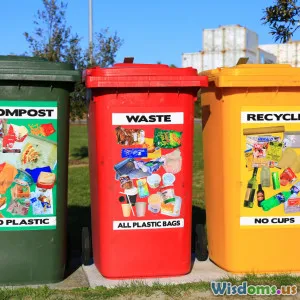
The Real Reasons Recycling Rates Are Stagnating Worldwide
8 min read Exploring the critical factors behind the global stagnation in recycling rates and why solutions must evolve beyond common misconceptions. (0 Reviews)
The Real Reasons Recycling Rates Are Stagnating Worldwide
Introduction
Despite decades of global awareness campaigns, policy initiatives, and technological advances, recycling rates worldwide have hit a frustrating plateau. This stagnation puzzles policymakers, environmentalists, and well-meaning consumers alike, especially amid growing climate concerns. What invisible forces are hindering progress? Why aren’t recycling rates climbing faster, and what fundamentals must we rethink?
Unpacking these questions reveals a complex web of economic, technical, behavioral, and regulatory factors that obstruct effective recycling. Understanding these issues is critical not to despair but to empower efforts that go beyond traditional solutions. This article explores the underrecognized causes behind stagnant recycling rates and provides a roadmap for reinvigorating global recycling programs with realism and innovation.
1. Economic Realities: The Market for Recyclables is Fragile
A primary barrier to increasing recycling rates lies in the harsh economics of recycled materials. Unlike virgin raw materials, whose prices are driven by predictable commodity markets, recyclable materials face several issues:
1.1 Fluctuating Commodity Prices
The value of recovered paper, plastics, and metals can vary drastically based on global demand, trade policies, and even geopolitical tensions. For example, the Chinese National Sword policy in 2018 banned the import of many recyclable wastes, snapping a previously large market segment and forcing sudden stockpiles or process shutdowns worldwide.
1.2 High Processing Costs
Sorting and cleaning recyclables require sophisticated technologies and significant labor costs. Glass, in particular, is expensive to process due to fragility and contamination risks, making it sometimes cheaper to produce new glass than recycle.
1.3 Limited Infrastructure Investment
Many regions, especially in developing countries, lack the necessary infrastructure—advanced sorting facilities and collection systems—to keep recyclables valuable and uncontaminated. Even in developed regions, aging facilities cannot handle the complexity or volume of current waste streams.
“Recycling must be economically viable to be sustainable. When recyclers face volatile markets, profitability suffers, and so does recycling intensity,” says Dr. Helena Pittman, an environmental economist at the University of Cambridge.
2. Contamination: The Invisible Killer of Recyclables
One of recycling’s most persistent challenges is contamination—the mixing of non-recyclable or dirty materials in recycling bins. This not only lowers the quality of output but can lead to entire batches being landfilled.
2.1 Consumer Confusion and Behavior
Complex or inconsistent recycling guidelines across cities and countries cause confusion. For example, a plastic bottle in one city might be recyclable while the same item in another might not. Packaging designed without recyclability in mind also contributes to issues.
2.2 Impact on Processing Facilities
Recycling sorting machinery struggles to handle contamination. Food-soiled materials, plastic bags tangling machines, and hazardous wastes contaminate otherwise recyclable batches.
Case in Point
In the United States, an estimated 25% of recyclables collected are contaminated, leading to costly processing delays and wasted efforts. New York City’s Department of Sanitation attributes recycling contamination as a top reason for recycling program inefficiency.
3. Policy and Regulatory Gaps
Policy frameworks around recycling remain inconsistent and under-enforced globally.
3.1 Lack of Harmonized Recycling Standards
Without standardized definitions of recyclable materials or universal collection practices, cross-jurisdictional recycling success is fragmented. This patchwork of policies confuses both consumers and businesses.
3.2 Insufficient Producer Responsibility Rules
Extended Producer Responsibility (EPR) programs, which mandate companies to manage the lifecycle of their products, including waste collection and recycling, continue to evolve slowly. Countries leading in EPR—like Germany and South Korea—show significantly higher recycling rates.
3.3 Incentives and Penalties
Many governments do not sufficiently incentivize composting, reuse, or innovative recycling technologies nor implement penalties for contamination or wasteful practices. These weak signals fail to change behaviors on the ground.
4. The Role of Consumer Behavior and Education
Recycling is not merely an infrastructure issue but deeply rooted in human behavior.
4.1 The Recycle vs. Reuse Paradigm
Overemphasis on recycling sometimes overshadows the importance of reducing and reusing materials. This imbalance perpetuates a linear economy mindset rather than fostering circularity.
4.2 Public Awareness and Motivation
Studies indicate that convenience is a major driver—if recycling requires extra time or effort, participation drops. Further, many campaigns focus on environmental guilt, which can cause disengagement rather than empowerment.
4.3 The Problem of 'Wishcycling'
Many consumers place non-recyclable items hoping they might get recycled. This misdirected hope harms the process, exacerbating contamination problems.
5. Technological and Material Design Challenges
Recycling technologies have advanced, but significant obstacles remain.
5.1 Complex Material Composition
Modern packaging is increasingly made from multilayered plastics or composites to improve functionality but these designs hinder recyclability.
5.2 Lack of Investment in Innovation
Private and public investments often shy away from recycling technology innovation, given uncertain returns.
“Advancements like chemical recycling show promise but currently face scalability and cost hurdles,” explains Jane Tseng, research director at GreenTech Innovations.
Conclusion: Rethinking Recycling for a Sustainable Future
The stagnation in recycling rates worldwide is not a failure of individual responsibility alone but a symptom of systemic complexity involving economics, contamination, policies, technology, and behavior. Incremental fixes have limited impact without addressing these interconnected challenges.
To move forward:
- Policymakers must harmonize recycling standards and incentivize sustainable design and producer responsibility.
- Industry players should invest in materials innovation for easier recyclability and scalable processing technologies.
- Consumers need clearer guidance and encouragement focused on reducing waste through both reuse and recycling.
- Communities should build resilient infrastructure tailored to local economic and material realities.
Only by confronting these real reasons with coordinated action can recycling truly become a powerful pillar of the circular economy and climate mitigation efforts.
Together, knowledge and action will redefine recycling from a stagnant challenge to a dynamic opportunity for sustainable resource stewardship worldwide.
Rate the Post
User Reviews
Popular Posts

















